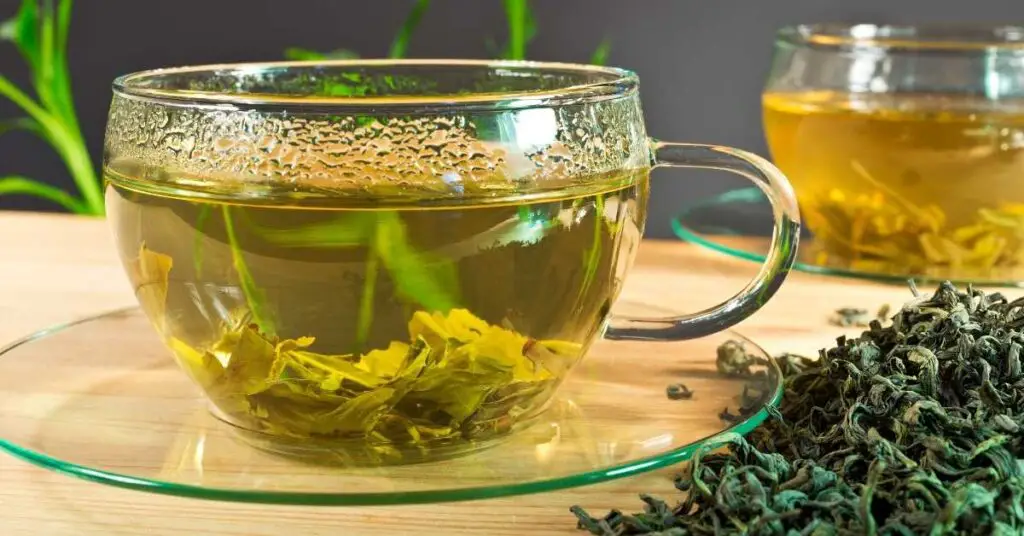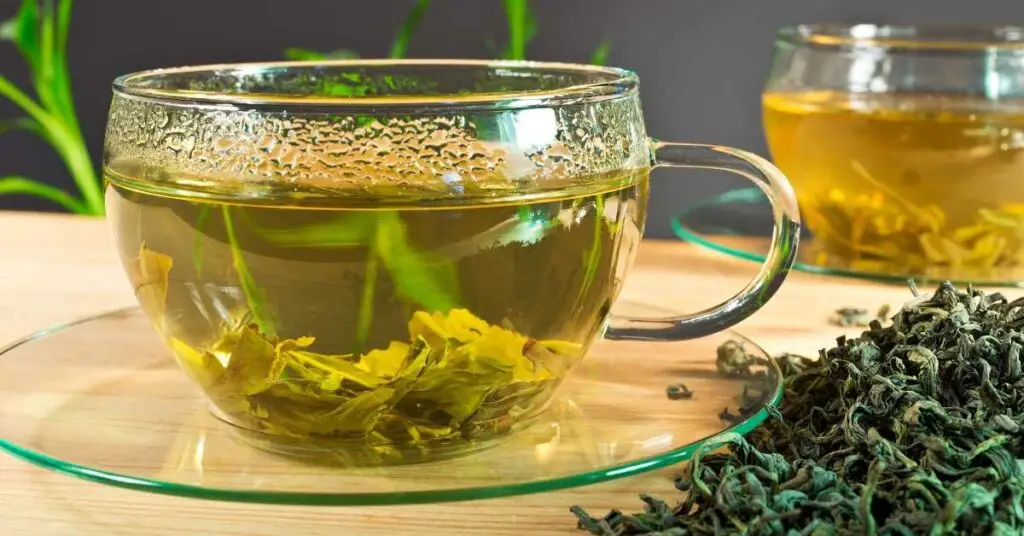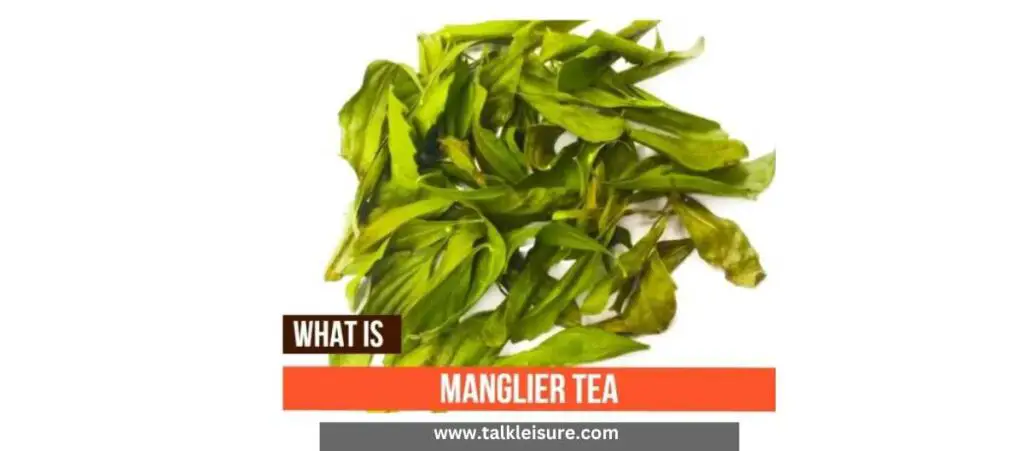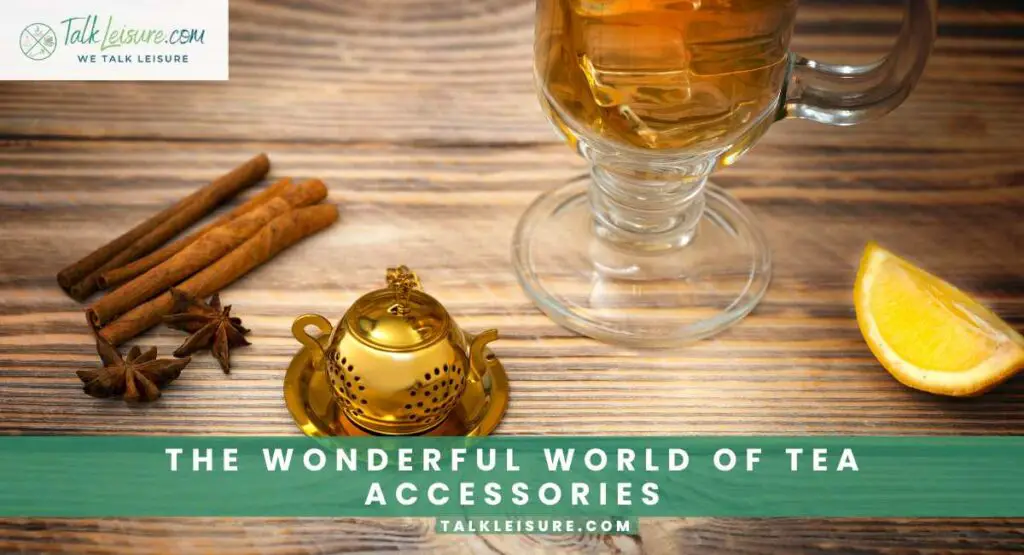In the quiet embrace of ancient traditions, tea weaves a tapestry of enchanting stories and mythical origins. From the mythical Emperor Shen Nong’s serendipitous discovery to the Zen-inspired elegance of the Japanese Tea Ceremony, each tale unravels a world where tea transcends its humble leaves.
Journey through misty mountains with Da Hong Pao and venture to the high plateaus of Tibet, where buttered brews warm the soul. Trace the steps of traders along the Silk Road and witness tea’s ascent to royalty in the British parlors.
Join monks in their quest for enlightenment, and finally, embrace the modern tea revival. This is the saga of tea – a beverage that has shaped cultures, kindled spirits, and left an indelible mark on the world.
Also read: A beginner’s guide to understanding tea grades and classifications.
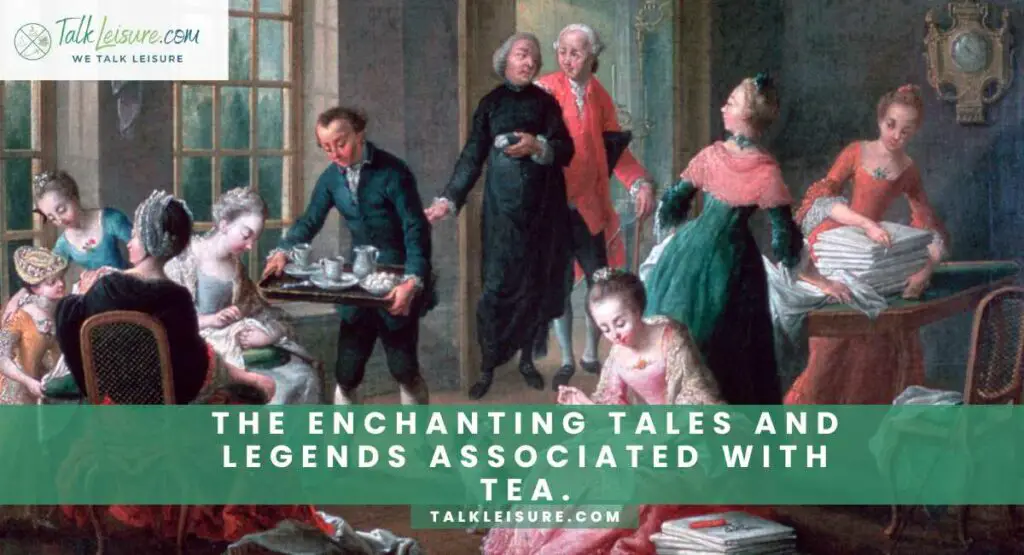
Introduction to Tea Legends
Ah, the enchanting world of tea! It’s not just leaves steeped in hot water; it’s a journey through centuries of culture, legends, and a whole lot of sipping satisfaction. So, grab your favorite cuppa, and let’s embark on this magical ride!
A Sip Through Time
Picture this: ancient China, circa 2737 BCE. There’s a chap named Emperor Shen Nong, pottering about in his garden. Now, he wasn’t your average gardener. Shen Nong was a bit of a pioneer and a risk-taker in the world of horticulture. One fine day, he decides to sample a few leaves from a random bush. What was that bush, you ask? It was the humble tea plant! Legend has it that this fateful sip marked the birth of our beloved tea.
Shen Nong: The Original Tea Critic
Now, let’s talk about Shen Nong for a second. This guy was practically the Gordon Ramsay of ancient China, but instead of lamb sauce, he was all about herbs. He was known for tasting plants to figure out their properties, and guess what? Tea passed his rigorous taste test with flying colors. He not only found it delicious but also hailed it for its medicinal properties. And just like that, tea went from being just another shrub to a bona fide superstar.
Brewing Up a Storm: Tea’s Global Odyssey
But hold on, our tea tale doesn’t stop there! From ancient China, it embarked on a grand adventure, hitching rides on caravans along the Silk Road, spreading its aromatic influence across continents. It’s like the original influencer, making its mark in new territories with each sip.
Brewing the Perfect Storm (of Myths and Legends)
Now, what makes tea truly special are the stories, the myths, and the legends that have woven themselves around it. These aren’t just tales of taste, but tales of triumph, transformation, and tantalizing experiences. Each cup holds within it a piece of history, a splash of culture, and a dash of magic.
So, dear reader, get ready to be transported through time and taste buds as we unravel the enchanting tales and legends associated with tea. From emperors to monks, from misty mountains to royal courts, we’ve got it all brewing for you.
Up next, we’re delving into the legend of Emperor Shen Nong and how he stumbled upon the world’s first brew. It’s a tale of taste tests and tea trees that’ll leave you steeped in wonder!
The Legend of Emperor Shen Nong
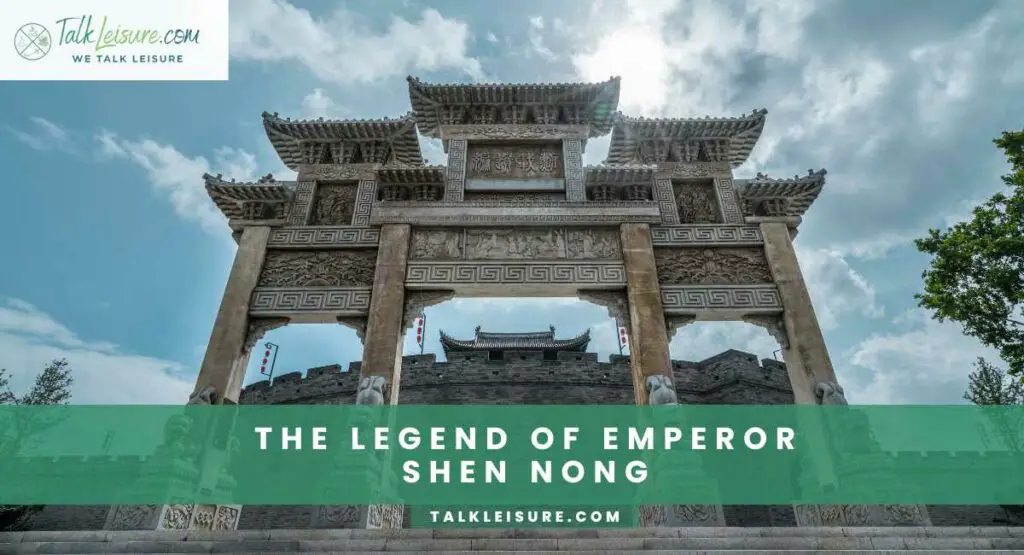
Welcome to the epicenter of tea’s origin story – the realm of Emperor Shen Nong, where myths intertwine with reality and a cup of tea holds the power to heal.
Shen Nong: The Ultimate Trailblazer
Picture ancient China, a land of sprawling fields and curious minds. In the midst of it all was Emperor Shen Nong, a figure whose name is synonymous with herbal wisdom. This guy wasn’t content with your run-of-the-mill chamomile tea; he was on a mission to uncover the secrets of every leaf, root, and stem. And one day, as the story goes, he stumbled upon a curious little shrub with leaves that beckoned to be tasted.
A Sip That Changed History
Now, let’s be clear, this wasn’t a casual afternoon tea. Shen Nong was on a quest for knowledge. With characteristic boldness, he decided to give those leaves a nibble. Lo and behold! What ensued was a revelation. The flavors danced on his palate, and he felt a surge of vitality coursing through his veins. This wasn’t just a refreshing drink; it was a portion of vitality, an elixir of life!
Tea’s Medicinal Marvels
Emperor Shen Nong was no stranger to the world of herbs and their healing powers. He was like a walking encyclopedia of ancient remedies. And when he added tea to his repertoire, he discovered a whole new dimension of medicinal magic. It was hailed for its ability to invigorate the spirit, soothe the body, and clear the mind. Little did Shen Nong know that he had unearthed a treasure that would resonate through millennia.
The Legacy of Shen Nong
Fast forward to today, and we’re still reaping the benefits of Shen Nong’s pioneering palate. His legacy lives on in every teacup, as we savor not just a beverage, but a tradition steeped in history. The tale of Emperor Shen Nong isn’t just about a man and his garden; it’s about the birth of a cultural icon.
So, as you savor your next cup of tea, raise it to Emperor Shen Nong, the original tea connoisseur, whose taste buds changed the course of history.
Bodhidharma and the Origins of Zen Tea Ceremony
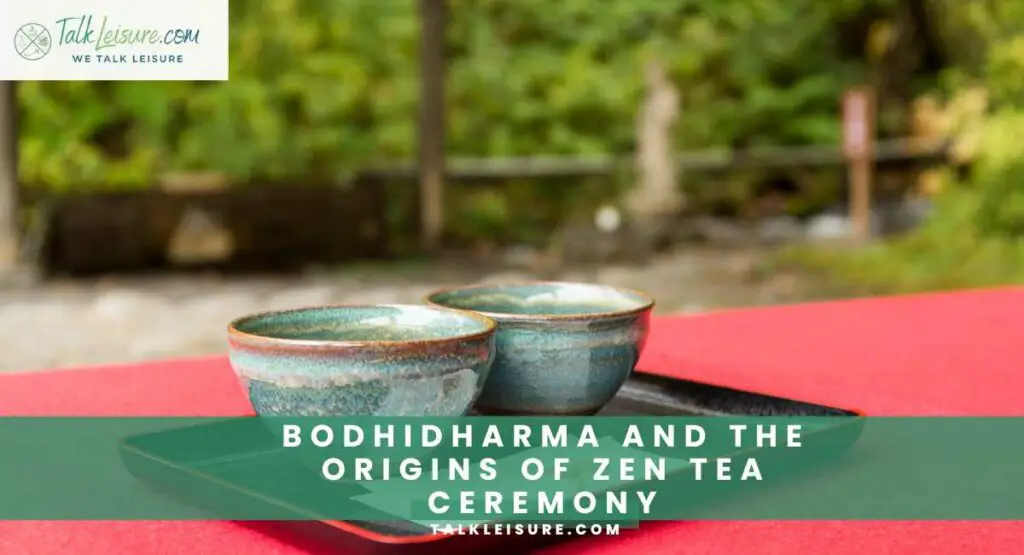
Welcome to the serene world of Zen, where tea became not just a drink, but a meditative practice, thanks to a wandering sage named Bodhidharma.
Brewing Enlightenment: The Zen Connection
Close your eyes and imagine ancient China, where mist-covered mountains whispered secrets to those who listened. In this landscape of introspection, Bodhidharma, a wise sage, brought with him not just wisdom, but a profound connection between meditation and tea. He understood that a cup of tea wasn’t just a beverage; it was a pathway to inner peace.
The Legend Unfolds: Bodhidharma’s Journey
Legend has it that Bodhidharma embarked on a spiritual quest that led him to a monastery in southern China. Upon his arrival, he was met with skepticism, and some even accused him of idleness. But Bodhidharma was not deterred. To convey his teachings, he needed a tool that would bridge the gap between the physical and the metaphysical. And thus, he turned to tea.
The Zen Tea Ceremony: More Than Meets the Eye
Enter the Zen Tea Ceremony, or Chanoyu in Japanese. It’s not just about pouring hot water over leaves; it’s a choreographed dance of mindfulness. Every movement, every gesture, is a meditation in itself. From the precise placement of the tea utensils to the careful whisking of matcha, it’s a symphony of simplicity and intention.
Finding Zen in Every Sip
The beauty of the Zen Tea Ceremony lies in its ability to transcend the act of drinking. It’s an experience that invites you to be present, to savor each moment. As you sip, you’re not just tasting tea; you’re tasting serenity, you’re tasting enlightenment.
Bodhidharma’s Legacy
Bodhidharma’s influence doesn’t stop with the ceremony. His teachings, entwined with the art of tea, continue to inspire seekers of inner peace around the world. The Zen Tea Ceremony stands as a testament to the profound connection between the mind, the body, and the humble tea leaf.
So, the next time you find yourself in the company of a cup of tea, take a moment to channel your inner Bodhidharma. Embrace the stillness, let the warmth seep into your soul, and remember that in every sip, there’s a path to enlightenment.
The Japanese Tea Ceremony: Chanoyu
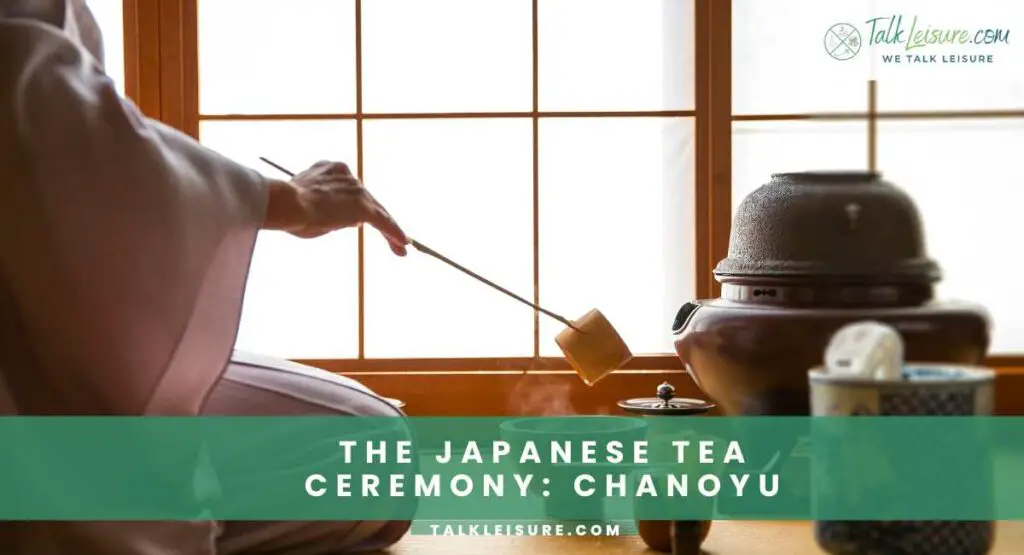
Enter the land of the rising sun, where tea becomes an art form, a spiritual practice, and a way of life – all thanks to the revered Japanese Tea Ceremony, or Chanoyu.
The Way of Tea: Chanoyu Unveiled
In the heart of Japan, a cultural revolution was brewing, and it wasn’t just in the samurai dojos. It was in the serene tearooms, where the Japanese Tea Ceremony took center stage. Chanoyu, or “The Way of Tea,” is a choreographed performance that transcends mere refreshment. It’s a ritual, an experience, and a profound journey into the art of mindfulness.
A Dance of Harmony and Respect
Picture this: a tranquil tatami-matted room, adorned with carefully chosen utensils. The host, draped in a kimono, moves with grace and precision, as if every step is a brushstroke on the canvas of serenity. The guests, in turn, receive the tea with utmost respect, acknowledging not just the brew, but the effort and intention behind it. It’s a dance of harmony, a symphony of manners.
The Tea, the Ceremony, and the Heart
But what makes Chanoyu truly special is the philosophy that underpins it. It’s not just about preparing and consuming tea; it’s about being present in the moment. It’s about recognizing the impermanence of life and finding beauty in simplicity. It’s a dialogue between the host, the guests, and the elements, a conversation that transcends words.
The Eternal Dance of Chanoyu
Centuries have passed, and yet, the Japanese Tea Ceremony continues to thrive. It’s not merely a tradition; it’s a living, breathing art form that has found its way into the hearts of tea enthusiasts around the world. Each ceremony is a testament to the enduring legacy of this ancient practice.
A Bow to the Masters of Chanoyu
As we raise our cups to the profound artistry of Chanoyu, we pay homage to the dedicated practitioners and masters who have kept this tradition alive. Their skill, their spirit, and their dedication are the threads that weave the tapestry of Chanoyu.
So, dear reader, the next time you witness or partake in a Japanese Tea Ceremony, know that you’re not just witnessing a performance; you’re witnessing a journey into the very essence of tea, culture, and the human spirit.
The Legend of the Wuyi Mountains and Da Hong Pao Tea
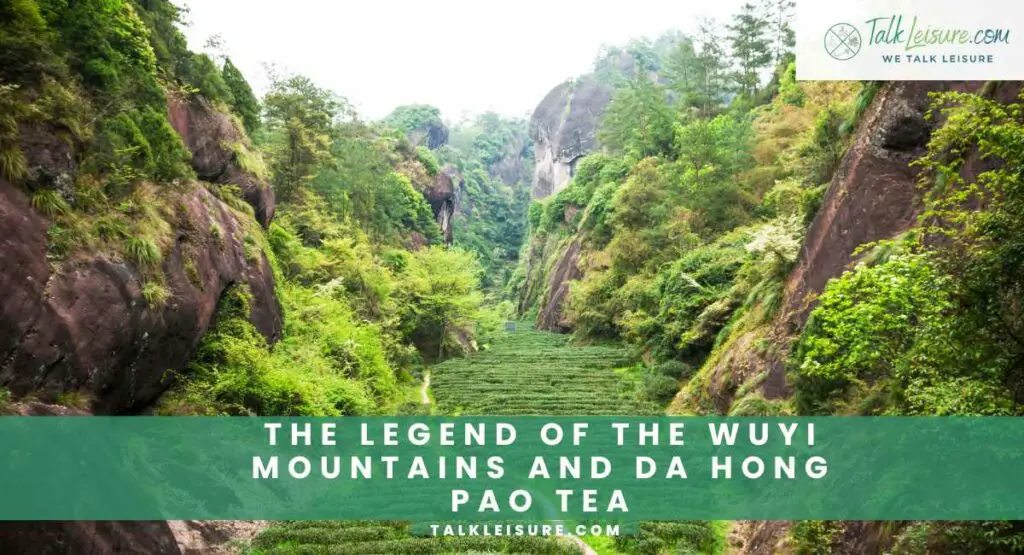
Venture into the mist-shrouded peaks of the Wuyi Mountains in China, where a legendary tea known as Da Hong Pao holds court, surrounded by tales of emperors, monks, and supernatural origins.
The Enchanted Realm of Wuyi
Nestled in the Fujian province, the Wuyi Mountains are a landscape straight out of a fairy tale. With their craggy cliffs and lush forests, they set the stage for one of the most captivating legends in the world of tea. It’s here, amidst the clouds and the whispering leaves, that Da Hong Pao, or “Big Red Robe,” came into being.
The Robe of Legend
Legend has it that in ancient times, a poor scholar was passing through the Wuyi Mountains, seeking shelter from a storm. He stumbled upon a small temple and took refuge there. To show his gratitude, he gifted the temple’s monks with red robes, and in return, they offered him tea made from the leaves of ancient tea trees. Little did he know, this simple act of kindness would lead to the birth of a legend.
The Miracle of Da Hong Pao
As the scholar sipped the tea, he felt a surge of energy and clarity wash over him. It was as if the very essence of the mountains had infused itself into the leaves. Word of this miraculous tea spread like wildfire, and soon, it caught the attention of the Emperor himself. He sent imperial robes to drape over the tea bushes as a sign of honor, forever bestowing upon it the name “Da Hong Pao.”
Guardians of the Tea Trees
Today, the ancient tea trees that gave birth to Da Hong Pao still stand tall in the Wuyi Mountains, their gnarled trunks a testament to centuries of history. They are tended to with the utmost care, as if they were sacred relics. The tea that is harvested from these trees carries with it not just a taste, but a legacy.
The Legend Lives On
With every sip of Da Hong Pao, we taste the echoes of that fateful encounter in the Wuyi Mountains. The legend endures, reminding us that sometimes, the most extraordinary stories are woven into the fabric of everyday acts of kindness.
So, the next time you brew a cup of Da Hong Pao, take a moment to appreciate the journey that brought this legendary tea from the ancient mountains to your teapot.
The Tale of Princess Wen Cheng and Tibetan Butter Tea
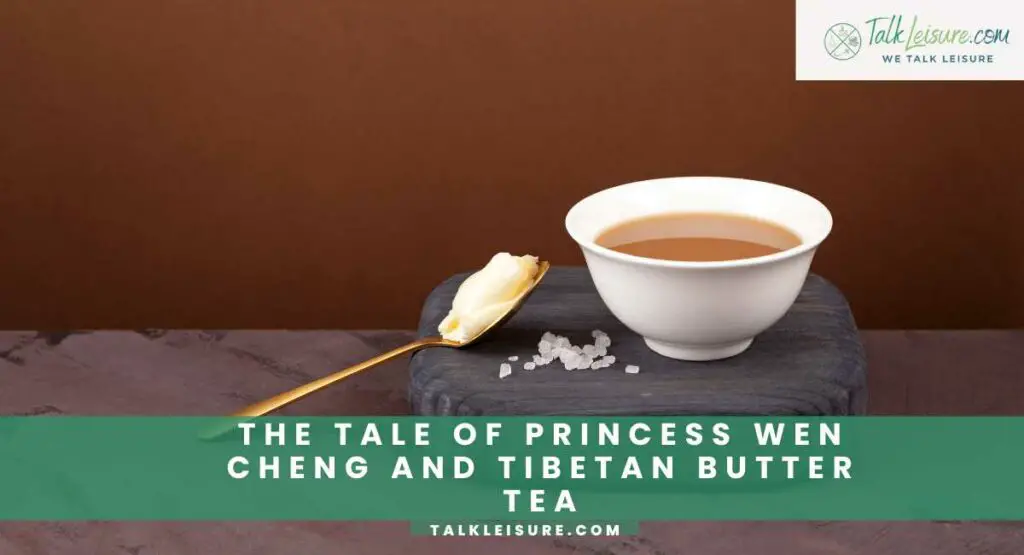
Journey to the high plateaus of Tibet, where tea takes on a unique form in the hands of a princess, becoming a vital part of a culture known for its resilience and warmth.
The Roof of the World: Tibet’s Chilling Challenge
Tibet, a land of stark contrasts, with its towering peaks and sweeping plateaus, is not for the faint of heart. Surviving in this high-altitude environment required sustenance that could withstand the biting cold, and thus, Tibetan Butter Tea was born.
The Princess and the Journey of a Lifetime
In the 7th century, a Chinese princess named Wen Cheng embarked on an epic journey across treacherous terrain to marry the Tibetan king, Songtsen Gampo. Alongside her, she brought not just her dowry, but a precious cargo: tea leaves from China. It was a gesture of cultural exchange that would shape the future of Tibetan tea culture.
The Art of Tibetan Butter Tea
Tibetan Butter Tea, or “Po Cha,” is a concoction like no other. A strong brew of tea leaves is mixed with yak butter, salt, and sometimes even grains like barley or wheat. The result is a hearty, nourishing drink that warms the body and fortifies the spirit, making it an essential part of Tibetan daily life.
The Warmth of a Thousand Butter Lamps
In the harsh climes of Tibet, where winters are unforgiving, Tibetan Butter Tea serves as more than just sustenance. It’s a gesture of hospitality, a symbol of unity, and a reminder of the strength that lies within the Tibetan people. It’s said that a cup of Po Cha can warm you from the inside out, providing not just physical comfort, but a sense of belonging.
Butter Tea: A Taste of Tibetan Resilience
Today, as you take a sip of Tibetan Butter Tea, you’re not just tasting a beverage; you’re tasting the legacy of a princess’s journey, the resilience of a people, and the warmth of a culture that thrives in the face of adversity.
So, let the steam rise from your cup and let the flavors transport you to the high plateaus, where every sip is a tribute to the indomitable spirit of Tibet.
The Silk Road and the Spread of Tea
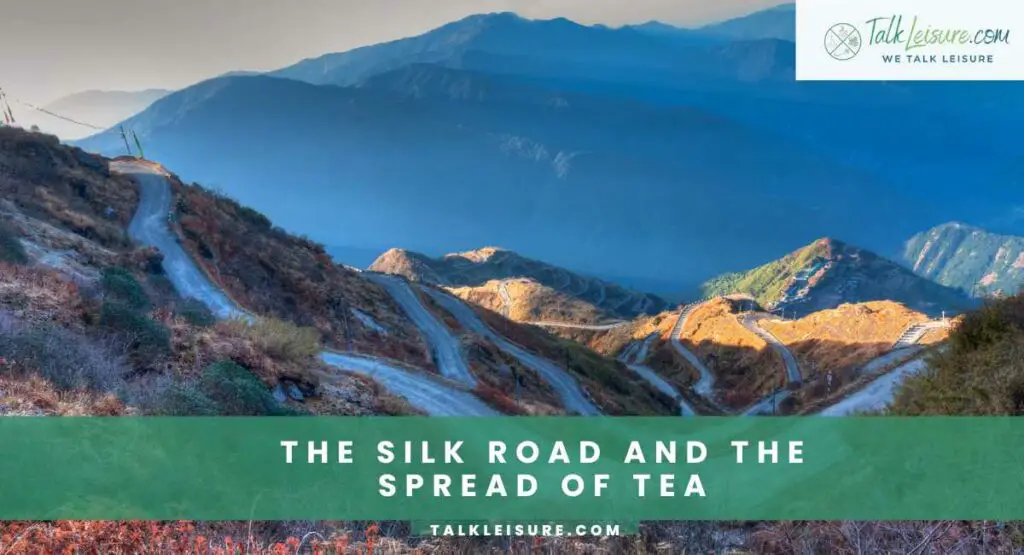
Embark on a historical journey along the ancient Silk Road, where caravans of traders and travelers carried not only goods, but also the seeds of a cultural revolution – the beloved tea leaf.
The Silk Road: A Tapestry of Trade and Culture
Picture a bustling network of trade routes, stretching across continents like veins in a body. This was the Silk Road, a lifeline of commerce and cultural exchange that connected the East and the West. And woven into the fabric of this grand tapestry was tea.
The Traveling Leaves: Tea’s Epic Odyssey
Tea, once confined to the mountains of China, began its grand adventure along the Silk Road. It journeyed alongside precious silks, spices, and exotic treasures, finding its way into the hearts and cups of people in far-off lands. Each step of this epic odyssey was marked by a fusion of cultures and a deepening appreciation for the humble tea leaf.
Traders and Trailblazers: Tea’s Ambassadors
Imagine the caravans, laden with goods and dreams, winding their way through deserts, mountains, and bustling marketplaces. Among the commodities that exchanged hands, tea stood out as a treasure, sought after for its exotic allure and medicinal properties. Traders became unwitting ambassadors, spreading not just tea, but the stories and legends that surrounded it.
A Taste of Home in Foreign Lands
As tea made its way to distant shores, it brought with it a taste of the East, a sip of solace for those far from home. It became a bridge between cultures, a symbol of hospitality, and a source of comfort in unfamiliar terrain. The teahouses that sprung up along the Silk Road were more than just places to quench thirst; they were oases of camaraderie and cultural exchange.
Tea’s Endless Journey
Today, as we sip our cups of tea, we’re reminded of the incredible journey that brought this humble leaf from ancient China to our tables. The Silk Road may have faded into the annals of history, but its legacy lives on in the global tea culture we cherish today.
So, the next time you take a sip, raise your cup to the intrepid travelers and traders who paved the way for tea to traverse continents and capture hearts around the world.
Tea and British Royalty: Legends of Afternoon Tea
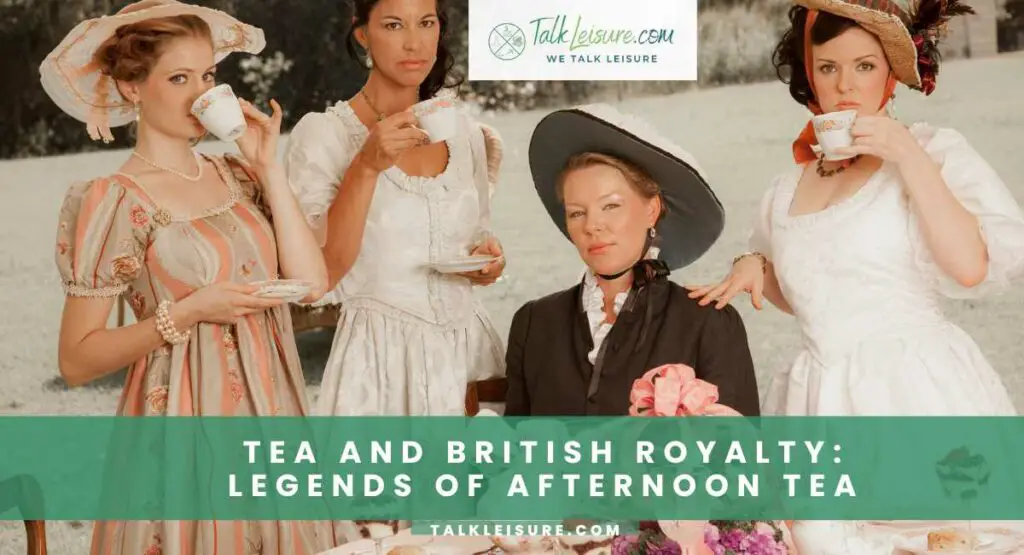
Step into the elegant parlors of England, where tea became more than a beverage; it became a ritual of refinement and a cornerstone of social tradition, thanks to a duchess with a penchant for parties.
The British Love Affair with Tea
Tea arrived on British shores like a gust of exotic winds, captivating the senses and igniting a passion that would shape the nation’s culture for centuries to come. But it wasn’t just the brew that bewitched the British; it was the ceremony, the camaraderie, and the sheer indulgence of it all.
Anna, the Duchess of Bedford: A Tea Pioneer
Enter Anna, the Duchess of Bedford, a lady of refinement and taste. Legend has it that in the early 19th century, Anna, plagued by the “sinking feeling” in the late afternoon, initiated a tradition that would forever change the course of British teatime. She began inviting friends to her chambers for a modest repast of tea and light fare, effectively inventing what we now know as afternoon tea.
The Elegance of Afternoon Tea
As word spread, afternoon tea evolved into an occasion of grandeur. Elaborate table settings, dainty sandwiches, delicate pastries, and of course, the finest teas, all came together in a symphony of indulgence. It wasn’t just about quenching thirst; it was about reveling in refinement.
Queen Victoria’s Endorsement
When Queen Victoria, the epitome of British royalty, adopted afternoon tea as part of her routine, it solidified the practice as a societal norm. It wasn’t long before the entire nation followed suit, with tea becoming a cornerstone of British culture and etiquette.
Afternoon Tea: A Legacy of Elegance
Today, as we partake in the ritual of afternoon tea, we’re not just sipping a beverage; we’re taking part in a tradition steeped in history and elegance. It’s a nod to an era of refinement, a celebration of camaraderie, and a testament to the enduring allure of tea.
So, whether you indulge in a formal afternoon tea or simply enjoy a quiet moment with a cuppa, remember that you’re partaking in a legacy that spans generations and continents.
Legends of Tea and Enlightenment
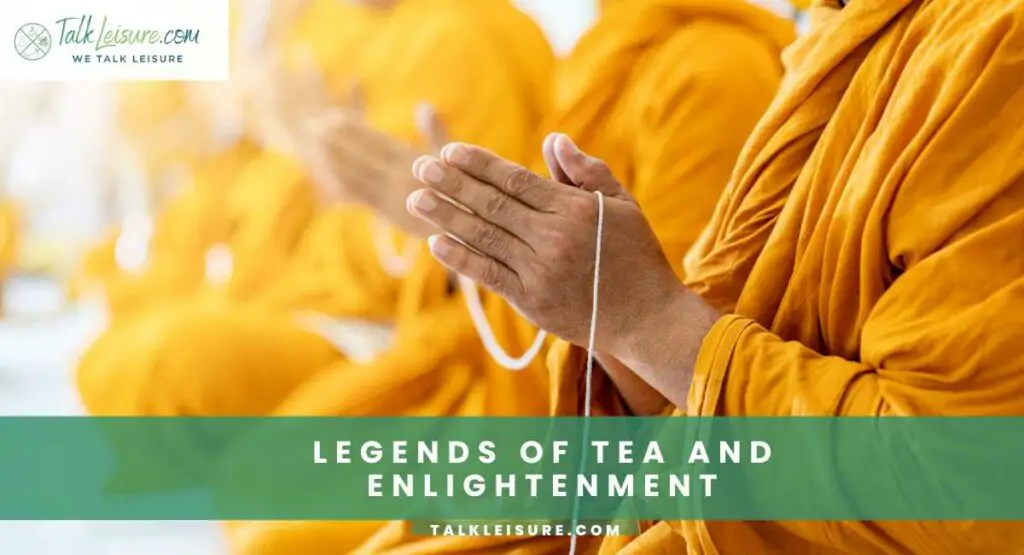
Embark on a spiritual journey, where tea becomes a vessel for meditation, introspection, and enlightenment, connecting seekers of truth with a higher plane of existence.
The Zen of Tea: A Path to Enlightenment
Tea, in its essence, is a reflection of mindfulness. But in the hands of monks and sages, it transcends a mere beverage; it becomes a conduit for spiritual awakening. The union of tea and meditation creates a space where the boundaries between the self and the universe blur, allowing for profound insights to emerge.
Monks and the Way of Tea
In monasteries across Asia, tea became an integral part of the meditative process. The act of preparing and partaking in tea was elevated to an art form, a practice of intentional presence. The simplicity of the ceremony was a canvas upon which profound spiritual experiences were painted.
Wu De and the Global Tea Hut
In more recent times, figures like Wu De have taken up the mantle of integrating tea and spirituality. The Global Tea Hut, an international community centered around the practice of tea, embodies the idea that every cup of tea can be a step towards enlightenment. It’s a reminder that the wisdom of tea transcends cultures and borders.
Tea and Mindfulness: A Modern Practice
In today’s fast-paced world, the marriage of tea and mindfulness continues to find resonance. Tea ceremonies, both formal and informal, offer moments of respite, a chance to be fully present in a world that often demands otherwise. It’s a practice that invites us to savor each sip, to appreciate the now.
Tea’s Gift: A Gateway to Inner Peace
As you hold your cup, take a moment to be grateful for the journey that brought this leaf to your hands. Know that in every sip, there’s an opportunity for connection, for stillness, and for a taste of enlightenment.
So, let the steam rise, let the aroma envelop you, and let the warmth of the tea be a gentle reminder that amidst the chaos, there’s always a sanctuary within.
Modern Legends: The Tea Revival

Embark on a journey through time to witness the resurgence of tea culture in the 21st century, as passionate tea enthusiasts and innovative entrepreneurs breathe new life into this ancient tradition.
The Renaissance of Tea
In recent decades, we’ve witnessed a remarkable revival of interest in tea. What was once seen as a quaint, traditional drink has now become a dynamic and evolving industry. Tea has transcended its humble origins to become a global phenomenon, captivating the taste buds and imaginations of people worldwide.
The Rise of Specialty Tea
Gone are the days when tea was confined to standard tea bags and the occasional loose leaves. Today, the world of tea boasts an astonishing array of flavors, varieties, and blends. From delicate oolongs to robust pu-erhs, the diversity of tea offerings is a testament to the creativity and dedication of modern tea artisans.
Tea Masters and Innovators
Behind this resurgence are the passionate individuals who have dedicated themselves to the craft of tea. Tea masters, sommeliers, and entrepreneurs are pushing the boundaries of what’s possible with tea. They experiment with new processing techniques, source rare and unique tea leaves, and create innovative blends that redefine our understanding of this ancient beverage.
The Tea Ceremony Reimagined
While traditional tea ceremonies remain cherished, a new wave of tea enthusiasts is reimagining these rituals for the modern age. Contemporary tea ceremonies often fuse elements of mindfulness, meditation, and even technology, creating immersive experiences that resonate with a new generation of tea lovers.
Tea’s Place in the 21st Century
Tea has seamlessly integrated itself into modern lifestyles. From trendy tea lounges in bustling cities to online communities dedicated to sharing tea knowledge, the resurgence of tea is a testament to its enduring appeal. It’s not just a drink; it’s a lifestyle, a conversation starter, and a source of inspiration.
The Future of Tea
As we stand on the precipice of a new era, one can only imagine where the journey of tea will lead. With the continued passion and creativity of tea enthusiasts, we can expect even more exciting developments in the world of tea. The legacy of this ancient beverage is far from over.
So, as you savor your next cup of tea, take a moment to appreciate the vibrant community that surrounds it. Know that you’re a part of a movement that is shaping the future of tea culture.
Conclusion: Sipping Stories, Embracing Tradition
As we conclude our journey through the enchanting tales and legends associated with tea, we find ourselves immersed in a world where leaves transcend into legacies. From ancient emperors to modern enthusiasts, tea’s allure persists, a thread woven through time. It’s not merely a beverage; it’s a vessel of history, a conduit of culture, and a source of solace.
With each sip, we partake in a tradition that spans continents and epochs. So, as you raise your cup, remember that in every infusion lies a story, a connection to the past, and an invitation to savor the present. Here’s to the enduring magic of tea.
Frequently Asked Questions
- What is tea called in China?
In China, tea is called 茶 (chá). This word has been used for centuries to refer to the beverage made by infusing dried tea leaves in hot water. The term “chá” is widely recognized and used throughout various Chinese dialects and languages.
- What is chai vs tea?
“Chai” and “tea” are terms used to describe beverages, but they refer to different things in different cultures.
- Tea:
- Generic Term: In many English-speaking countries, “tea” refers to the aromatic beverage made by infusing dried tea leaves in hot water.
- Broad Usage: It can encompass various types of tea, including black, green, white, oolong, and herbal teas.
- Cultural Significance: Tea holds significant cultural and historical importance in countries like China, Japan, India, and Britain.
- Chai:
- Specific Preparation: “Chai” specifically refers to a spiced tea beverage that originated in India. It is made by brewing black tea with a blend of spices, typically including cardamom, cinnamon, ginger, cloves, and black pepper.
- Cultural Context: In India, “chai” is an integral part of daily life and social gatherings. It’s often prepared with milk and sweeteners.
- Global Popularity: The term “chai” has gained popularity internationally, particularly in coffee shops and cafes, where it is used to refer to spiced tea lattes inspired by the Indian tradition.
So, in summary, “tea” is a broad term for various infusions made from tea leaves, while “chai” specifically refers to a spiced tea beverage with roots in Indian culture.
- What does tea symbolize in literature?
In literature, tea often symbolizes moments of solace, reflection, and social connection. It serves as a metaphor for the small, simple pleasures that provide comfort and respite from the complexities of life. Additionally, the act of sharing tea can represent hospitality, camaraderie, and the bridging of cultural divides, making it a powerful symbol of unity and understanding.

